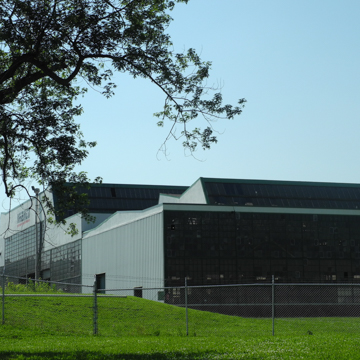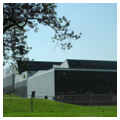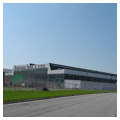You are here
Whemco Ohio Foundry, Inc.
Though Ohio’s industrial prominence, beginning in the nineteenth century and continuing until after World War II, is generally associated with major urban centers like Cleveland, Cincinnati, Dayton, Akron, Youngstown, and Toledo, it also had an unusual number of small-to-medium sized cities where industry prospered, including Lima, which was founded in 1831 in the northwestern part of the state. Industry in Lima developed following the discovery of oil in the area in the late nineteenth century, and its subsequent manufacturing boom included the production of railroad locomotives, automobile parts, and steel products. The Ohio Steel Foundry was founded in 1907 by local industrialists John E. Galvin, who was also associated with the Lima Locomotive Works. In the late 1930s, the company turned to architect Albert Kahn to design a vast glass-and-steel shed to house its roll and heavy machine shop.
By then Kahn was well known for innovative industrial buildings, but his other work in Ohio was in a decidedly different vein. The Stambaugh Building (1906) and the Mahoning National Bank (1910), both in Youngstown, were traditional and classically styled commercial structures. By contrast, the later factory building was inspired by the International Style of early-twentieth-century European modernism. With its white facade and ribbon windows, the Ohio Steel Foundry Roll and Heavy Machine Shop presents a striking composition.
This is an insistently horizontal building with two-story wings bookending a triple-volume center. It has a delicate glass enclosure and angled windows along the third floor, bringing light into the center space. The glass curtain wall turns the corners, explicitly articulating its independence from the structure, and the curtain wall is capped with a white fascia that follows the rhythm of the building’s two-three-two-story profile. In Kahn’s scheme for the Ohio Steel Foundry, transnational architectural influence reverses itself: while Swiss architect Le Corbusier described the influence of American factories on the International Style in his 1927 book Toward a New Architecture, European modernism clearly influenced the design of this particular American factory. Likely precedents included Peter Behren’s AEG Turbine Factory (1910) in Berlin and Walter Gropius’s Fagus Factory (1913) in Alfeld. At the same time, its composition and internal organization were largely dictated by the necessity of industrial production, notably the installation of a massive gantry extending the length of the nave-like building to support a mobile crane. Writing about the building in 1940, the critic Talbot Hamlin argued that here, in Lima, Kahn had “boldly spoken the new language of the industrial designer.” Kahn himself once said, “In spite of the fact that architecture today is in my opinion only about 10 percent art and 90 percent business, the architect must have constantly before him the final result—the artistic, the practical, and the economic.” Kahn’s Ohio buildings provide evidence of his goals.
Still in use for industrial production, the building is now the WHEMCO Ohio Foundry.
References
Speech by Albert Kahn to the Adcraft Club, “Thirty Minutes of American Architecture and Architects,” 11/22/1937, Box 1, Albert Kahn Collection, Bentley Historical Library, University of Michigan.
Banham, Reyner. A Concrete Atlantis: U.S. Industrial Building and European Modern Architecture 1900-1925. Cambridge: MIT Press, 1986.
Hamlin, Talbot. “Factories as Architecture.” Pencil Points21 (August 1940): 469-482.
Le Corbusier. Toward a New Architecture.Translated by Frederick Etchells. Reprint, London: The Architectural Press, 1927.
Wilson, Richard Guy, Dianne H. Pilgrim, and Dickran Tashjian. The Machine Age in America, 1919-1941. New York: The Brooklyn Museum in association with Harry N. Abrams, Inc., Publishers, 1986.
Writing Credits
If SAH Archipedia has been useful to you, please consider supporting it.
SAH Archipedia tells the story of the United States through its buildings, landscapes, and cities. This freely available resource empowers the public with authoritative knowledge that deepens their understanding and appreciation of the built environment. But the Society of Architectural Historians, which created SAH Archipedia with University of Virginia Press, needs your support to maintain the high-caliber research, writing, photography, cartography, editing, design, and programming that make SAH Archipedia a trusted online resource available to all who value the history of place, heritage tourism, and learning.

















